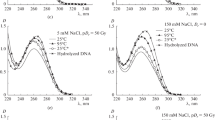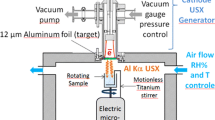Abstract
Clustered DNA damage induced by 10, 20 and 30 MeV protons in pBR322 plasmid DNA was investigated. Besides determination of strand breaks, additional lesions were detected using base excision repair enzymes. The plasmid was irradiated in dry form, where indirect radiation effects were almost fully suppressed, and in water solution containing only minimal residual radical scavenger. Simultaneous irradiation of the plasmid DNA in the dry form and in the solution demonstrated the contribution of the indirect effect as prevalent. The damage composition slightly differed when comparing the results for liquid and dry samples. The obtained data were also subjected to analysis concerning different methodological approaches, particularly the influence of irradiation geometry, models used for calculation of strand break yields and interpretation of the strand breaks detected with the enzymes. It was shown that these parameters strongly affect the results.









Similar content being viewed by others
References
Adhikary A, Becker D, Palmer BJ, Heizer AN, Sevilla MD (2012) Direct formation of the C5′-radical in the sugar-phosphate backbone of DNA by high-energy radiation. J Phys Chem B 116(20):5900–5906
Adhikary A, Becker D, Sevilla MD (2014) Electron spin resonance of radicals in irradiated DNA. In: Lund A, Shiotani M (eds) Applications of EPR in radiation research. Springer, Berlin, pp 299–352
Asaithamby A, Hu B, Chen DJ (2011) Unrepaired clustered DNA lesions induce chromosome breakage in human cells. PNAS 108(20):8293–8298
Berger MJ, Coursey JS, Zucker MA, Chang J (2005) ESTAR, PSTAR, and ASTAR: computer programs for calculating stopping-power and range tables for electrons, protons, and helium ions (version 1.2.3). http://physics.nist.gov/Star. Accessed 30 Oct 2014
Bin JH, Allinger K, Assmann W, Dollinger G, Drexler GA, Friedl AA, Habs D, Hilz P, Hoerlein R, Humble N, Karsch S, Khrennikov K, Kiefer D, Krausz F, Ma WJ, Michalski D, Molls M, Raith S, Reinhardt S, Röper B, Schmid TE, Tajima T, Wenz J, Zlobinskaya O, Schreiber J, Wilkens JJ (2012) A laser-driven nanosecond proton source for radiobiological studies. Appl Phys Lett 101:243701–243704
Bolivar F, Rodriguez RL, Greene PJ, Betlach MC, Heyneker HL, Boyer HW, Crosa JH, Falkow S (1977) Construction and characterization of new cloning vehicles. II. A multipurpose cloning system. Gene 2(2):95–113
Bolton PR, Borghesi M, Brenner C, Carroll DC, De Martinis C, Flacco A, Floquet V, Fuchs J, Gallegos J, Dn Giove, Green JS, Green S, Jones B, Kirby D, McKenna P, Neely D, Nuesslin F, Prasad R, Reinhardt S, Roth M, Schramm U, Scott GG, Ter-Avetisyan S, Tolley M, Turchetti G, Wilkens JJ (2014) Instrumentation for diagnostics and control of laser-accelerated proton (ion) beams. Phys Med 30(3):255–270
Cowan R, Collis CM, Grigg GW (1987) Breakage of double-stranded DNA due to single-stranded nicking. J Theor Biol 127:229–245
Do TT, Tang VJ, Konigsfeld K, Aguilera JA, Perry CC, Milligan JR (2012) Damage clusters after gamma irradiation of a nanoparticulate plasmid DNA peptide condensate. Radiat Environ Biophys 51(1):43–52
Durante M, Cucinotta FA (2008) Heavy ion carcinogenesis and human space exploration. Nat Rev Cancer 8:465–472
Gebicki S, Gebicki JM (1999) Crosslinking of DNA and proteins induced by protein hydroperodixes. Biochem J 338:629–636
Georgakilas AG, O’Neill P, Stewart RD (2013) Induction and repair of clustered DNA lesions: What do we know so far? Radiat Res 180(1):100–109
Girdhani S, Sachs R, Hlatky L (2013) Biological effects of proton radiation: What we know and don’t know. Radiat Res 179(3):257–272
Gulston M, Fulford J, Jenner T, de Lara C, O’Neill P (2002) Clustered DNA damage induced by γ radiation in human fibroblasts (HF19), hamster (V79-4) cells and plasmid DNA is revealed as Fpg and Nth sensitive sites. Nucleic Acid Res 30(15):3464–3472
Hada M, Georgakilas AG (2008) Formation of clustered DNA damage after high-LET irradiation: a review. J Radiat Res 49(3):203–210
Hall EJ, Hei TK (2003) Genomic instability and bystander effects induced by high-LET radiation. Oncogene 22(45):7034–7042
ICRU Report 16 (1970) Linear energy transfer. International Commission on Radiation Units and Measurements
Klimczak U, Ludwig DC, Mark F, Rettberg P, Schulte-Frohlinde D (1993) Irradiation of plasmid and phage DNA in water-alcohol mixtures: strand breaks and lethal damage as a function of scavenger concentration. Int J Radiat Biol 64(5):497–510
Kraft SD, Richter C, Zeil K, Baumann M, Beyreuther E, Bock S, Bussmann M, Cowan TE, Dammene Y, Enghardt W, Helbig U, Karsch L, Kluge T, Laschinsky L, Lessmann E, Metzkes J, Naumburger D, Sauerbrey R, Schurer M, Sobiella M, Woithe J, Schramm U, Pawelke J (2010) Dose-dependent biological damage of tumour cells by laser-accelerated proton beams. New J Phys 12:085003
Leloup C, Garty G, Assaf G, Cristovão A, Breskin A, Chechik R, Shchemelinin S, Paz-Elizur T, Livneh Z, Schulte RW, Bashkirov V, Milligan JR, Grosswendt B (2005) Evaluation of lesion clustering in irradiated plasmid DNA. Int J Radiat Biol 81(1):41–54
Malka V, Faure J, Gauduel YA, Lefebvre E, Rousse A, Phuoc KT (2008) Principles and applications of compact laser-plasma accelerators. Nat Phys 4(6):447–453
McMahon SJ, Currell FJ (2011) A robust curve-fitting procedure for the analysis of plasmid DNA strand break data from gel electrophoresis. Radiat Res 175(6):797–805
Milligan JR, Aguilera JA, Nguyen TTD, Paglinawan RA, Ward JF (2000) DNA strand-break yields after post-irradiation incubation with base excision repair endonucleases implicate hydroxyl radical pairs in double-strand break formation. Int J Radiat Biol 76(11):1475–1483
Pachnerová Brabcová K, Sihver L, Yasuda N, Matuo Y, Štěpán V, Davídková M (2014) Clustered DNA damage on subcellular level: effect of scavengers. Radiat Environ Biophys 53(4):705–712
Pachnerová Brabcová K, Štěpán V, Karamitros M, Karabín M, Dostálek P, Incerti S, Davídková M, Sihver L (2015) Contribution of indirect effects to clustered damage in DNA irradiated with protons. Radiat Prot Dosim. doi:10.1093/rpd/ncv15
Prise KM, Pullar CHL, Michael BD (1999) A study of endonuclease III-sensitive sites in irradiated DNA: detection of α-particle-induced oxidative damage. Carcinogenesis 20(5):905–909
Semenenko VA, Stewart RD (2006) Fast Monte Carlo simulation of DNA damage formed by electrons and light ions. Phys Med Biol 51(7):1693–1706
Shikazono N, Noguchi M, Fujii K, Urushibara A, Yokoya A (2009) The yield, processing, and biological consequences of clustered DNA damage induced by ionizing radiation. J Radiat Res 50(1):27–36
Śmiałek MA (2012) Early models of DNA damage formation. J Phys Conf Ser 373(1):012013
Śmiałek MA, Jones NC, Hoffmann SV, Mason NJ (2013) Measuring the density of DNA films using ultraviolet-visible interferometry. Phys Rev E 87:060701
Stefančíková L, Porcel E, Eustache P, Li S, Salado D, Marco S, Guerquin-Kern JL, Réfrégiers M, Tillement O, Lux F, Lacombe S (2014) Cell localisation of gadolinium-based nanoparticles and related radiosensitising efficacy in glioblastoma cells. Cancer Nanotechnol. doi:10.1186/s12645-014-0006-6
Sui L, Wang Y, Wang X, Kong FQ, Liu JC, Zhou PK (2013) Clustered DNA damage induced by protons radiation in plasmid DNA. Chin Sci Bull 58(26):3217–3223
Sutherland BM, Bennett PV, Saparbaev M, Sutherland JC, Laval J (2001) Clustered DNA damages as dosemeters for ionising radiation exposure and biological responses. Radiat Prot Dosim 97(1):33–38
Swarts SG, Sevilla MD, Becker D, Tokar CJ, Wheeler KT (1992) Radiation-induced DNA damage as a function of hydration: I. Release of unaltered bases. Radiat Res 129(3):333–344
Terato H, Ide H (2004) Clustered DNA damage induced by heavy ion particles. Biol Sci Space 18(4):206–215
Urushibara A, Shikazono N, O’Neill P, Fujii K, Wada S, Yokoya A (2008) LET dependence of the yield of single-, double-strand breaks and base lesions in fully hydrated plasmid DNA films by 4He2+ ion irradiation. Int J Radiat Biol 84(1):23–33
Ushigome T, Shikazono N, Fujii K, Watanabe R, Suzuki M, Tsuruoka C, Tauchi H, Yokoya A (2012) Yield of single- and double-strand breaks and nucleobase lesions in fully hydrated plasmid DNA films irradiated with high-LET charged particles. Radiat Res 177(5):614–627
von Sonntag C (2006) Free-radical-induced DNA damage and its repair, a chemical perspective. Springer, Berlin
Watanabe M (2007) The first target of radiation carcinogenesis is not DNA. Int Congr Ser 1299:21–24
Willers H, Dahm-Daphi J, Powel SN (2004) Repair of radiation damage to DNA. Brit J Cancer 90:1297–1301
Wyer JA, Butterworth KT, Hirst DG, Latimer CJ, Montenegro EC, Shah MB, Currell FJ (2009) Fragmentation and plasmid strand breaks in pure and gold-doped DNA irradiated by beams of fast hydrogen atoms. Phys Med Biol 54(15):4705–4721
Yogo A, Sato K, Nishikino M, Maeda T, Sakaki H, Hori T, Ogura K, Nishiuchi M, Teshima T, Nishimura H, Kondo K, Bolton PR, Kawanishi S (2011) Measurement of DNA double-strand break yield in human cancer cells by high-current, short-duration bunches of laser-accelerated protons. Jpn J Appl Phys 50(10):106401
Ziegler JF, Ziegler MD, Biersack JP (2010) SRIM—The stopping and range of ions in matter (2010). Nucl Instrum Methods B 268(11–12):1818–1823
Zlobinskaya O, Siebenwirth C, Greubel C, Hable V, Hertenberger R, Humble N, Reinhardt S, Michalski D, Röper B, Multhoff G, Dollinger G, Wilkens JJ, Schmid TE (2014) The effects of ultra-high dose rate proton irradiation on growth delay in the treatment of human tumour xenofrafts in nude mice. Radiat Res 181(2):177–183
Acknowledgments
This work has been supported by ESA Project No. ESTEC/ITT AO/1-7146/12/NL/GLC “Radiation Biological End Effects Models and Interfaces to Physics Models” and MEYS CR Project No. LD12008. L. Vyšín and L. Juha appreciate a partial financial support provided by the Czech Science Foundation under the Grant No. 13-28721S. M. Vlk is grateful for a partial financial support by MEYS CR Project No. LK21310. The irradiation has been realized at the CANAM (Center of Accelerators and Nuclear Analytical Methods) supported by the MEYS CR Project No. LM 2011019. The authors also appreciate valuable comments of Dr. Amitava Adhikary.
Author information
Authors and Affiliations
Corresponding author
Rights and permissions
About this article
Cite this article
Vyšín, L., Pachnerová Brabcová, K., Štěpán, V. et al. Proton-induced direct and indirect damage of plasmid DNA. Radiat Environ Biophys 54, 343–352 (2015). https://doi.org/10.1007/s00411-015-0605-6
Received:
Accepted:
Published:
Issue Date:
DOI: https://doi.org/10.1007/s00411-015-0605-6




